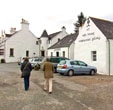 (Presentation to the Cross Party Group in the Scottish Parliament on Rural Policy, 19 February 2014)
(Presentation to the Cross Party Group in the Scottish Parliament on Rural Policy, 19 February 2014)
All rural development contributes to the rural economy – including housing, which is often controversial. In fact, rural areas need people in order to thrive and they have capacity to spare. Islay is home to 3500 people. Once there were almost 20,000 Ileachs.
Address the demographic mix, provide affordable and market housing, and we’ll have growing capacity for local products, improved services and enhanced tourism, better access to education and real responses to rural poverty – all in an attractive landscape managed to high standards. Who wouldn’t want that?
So what’s stopping us? Some people blame planning. Experience suggests that CAN be true but not always. Do we have a tendency to see rural areas as no go zones for development? An obsession with driving development to larger towns – a mid-20c response unsuited to many rural areas? Or defensive policy preventing poor quality development, but also stopping everything else?
Happily, NPF3 and SPP are highlighting the rural opportunity. There’s expanded rural content in both draft documents, telling a positive story. But we need to translate this story into action, into delivery on the ground, into local planning which creates the conditions to allow rural enterprise – including housing – to flourish.
We’ve been addressing proactive planning in East Lothian recently, working with Nick Wright Planning (NWP) on the East Lothian Rural Voice report. To inform the Main Issues Report, the Council undertook public engagement in their main towns. Local surveyors Chalmers & Co felt East Lothian’s rural voice should be heard directly, so approached the Council to organise a dedicated workshop. An unusual co-funded event ensued, attended by 40 people – residents, community groups, businesses, farmers, landowners. The conclusion? Planning needs to change.
Alongside this, we’re working (again with NWP) on a pilot project at Winton Estate in East Lothian, where an engagement-led estate wide (1000 acres) Vision is promoting a range of proposals for mineral extraction, visitor accommodation, social enterprise and other uses.
The East Lothian Rural Voice said planning policy is too strict and discourages development. East Lothian Council disagreed at that time. But if people PERCEIVE that planning is too restrictive they won’t even try to develop. That’s a problem. The Council is reviewing the report findings, monitoring the Winton pilot and will test new rural policy options in the Main Issues Report.
There’s no doubt that NPF3 and SPP take a positive stance, articulating the SG National Outcomes. Our LDPs need to do the same, tailoring solutions to suit different needs – some areas need multiple rural solutions. No single size fits all.
Pilot projects, new approaches – rural enterprise zones? – area specific ideas with clear objectives should be trialled. West Lothian’s Lowland Crofting is an well-known, if only partly successful example.
There’s an opportunity for the NPF to express spatial direction on a wider range of rural issues – including demographics and population – joining up thinking and breaking down silos.
And LDPs should integrate economic development and tourism strategies, Single Outcome Agreements and Community Plans. Planning is best placed to bring agencies, strategies and ambitions together, given its cross cutting nature.
We need to foster a positive attitude to rural development, promoting population growth, rural enterprise, local energy solutions. That includes a new attitude on landscape protection and management – North Harris Trust is a good example of a community working hand in hand with SNH.
Policy on development in the countryside needs a finer grain with objective-driven decisions. Weight and balance are needed. Planning is about value judgement and the public interest but that’s obscured by black and white thinking (and political shenanigans sometimes play a part).
Where pressure for housing in the countryside isn’t meeting a local need, some development might be permitted where it can also deliver affordable housing or workspace. Enabling development of this type is not a new concept.
Where rural schools are short of pupils, let’s direct housing and investment to their catchments. Argyll & Bute Council missed an opportunity to address this issue head on recently.
It’s important always to remember that rural residents and communities need to play a central role in driving sustainable place, enterprise and economic success. Recent Cairngorms National Park experience at Tomintoul & Glenlivet is an inspirational example. Increasingly, communities are taking a lead themselves.
Our experience with the East Lothian Rural Voice – and elsewhere – suggests that people don’t fear development or change where it is of a suitable scale and quality and proceeds at an appropriate pace – and where the planning process engages effectively with them.
“Poverty, to be picturesque, should be rural. Suburban misery is as hideous as it it pitiable.” Anthony Trollope, Author, 1815-1882
Richard Heggie
March 2013

